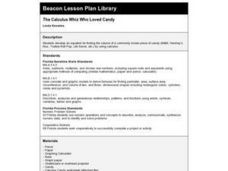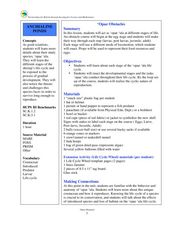Curated OER
Night Hike
Students explore Upham Woods at night and investigate about the special adaptations of nocturnal animals. They identify three nocturnal animals and how they are adapted to the night. Students explain what night vision is and how it works.
Curated OER
Honu Survivor The Green Sea Turtle Experience
Discuss prior knowledge of the green sea turtle. Students play a game where they are divided into two teams, predators and baby turtles. They receive "name" tags to tell which animal they are. The goal of the baby turtle is to get to the...
Curated OER
Mollusk of Interest
Student choose a mollusk that they are interested in and research it. They present their research to the class and compile all the information on mollusks in a packet. Information must include common and scientific name, family,...
Curated OER
The Calculus Whiz Who Loved Candy
Students develop an equation for finding the volume of a commonly known piece of candy (M&M, Hershey's Kiss, Tootsie Roll Pop, Life Saver, etc.) by using calculus.
Curated OER
Clay Exploration
Students create clay sculptures. In this sculpting lesson, students work in various stations to familiarize themselves with clay and use tools to make their own art piece.
Curated OER
Patterns in Nature Booklet
Students examine patterns on objects in nature, then use rubbings of these patterns to create pattern booklets.
Curated OER
Worry Critter
Third graders investigate what worrying is, its causes, feeling, and how to deal with it.
Curated OER
Touch N' Feel Box
Students are encouraged to use senses other than sight to record observations. They explore scientific questioning, observations and human senses (touch, hearing and sight). Students describe objects using their sense of touch and then...
Curated OER
Worksheet 35 - Fall 1995
In this math worksheet, students sketch the graphs labeling the point of intersection in the first quadrant. Then they find the area of Ω.
Curated OER
Butterfly Eggs
Students make butterfly eggs. In this butterfly instructional activity, students discuss the differences between butterfly eggs and other eggs. Students learn how butterflies lay their eggs and then make butterfly eggs out of clay.
Curated OER
Touch and Feel Box
Students investigate their sense of touch to help become more descriptive with their observations. For this sensory lesson, students reach inside a box to feel an object then guess what it is. Students then use both senses of touch and...
Curated OER
Opae Obstacles
Students explore the life cycle of shrimp. In this life cycle lesson, students research the different stages of a shrimp's life cycle. Students examine threats to the species in each stage of life.
Curated OER
Volcanoes
Pupils make a volcano out of a soda bottle, flower, salt, oil, and more. In this volcanoes lesson plan, students also read about volcanoes.
Curated OER
Make Sense of Nature
Learners participate in this program that heightens their awareness and curiosity of nature as well as their sense of adventure and exploring new surroundings. They identify and choose an object from nature after exploring it with other...
Curated OER
The Paleozoic Era Crossword
In this Paleozoic Era worksheet, students complete a 12 word crossword puzzle using given clues about the Paleozoic Era. Answers given on page 2.
Curated OER
Everyone can explore architecture
Students draw like an architect. In this interdisciplinary lesson, students research and draw several examples of different forms of architecture through societies, cultures and times, then present them to the class.

















